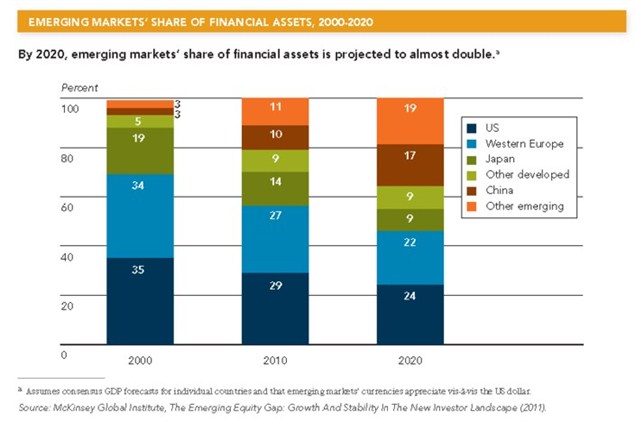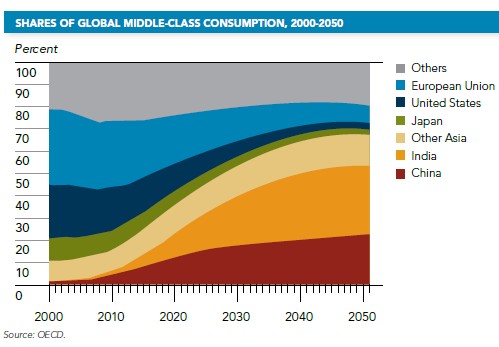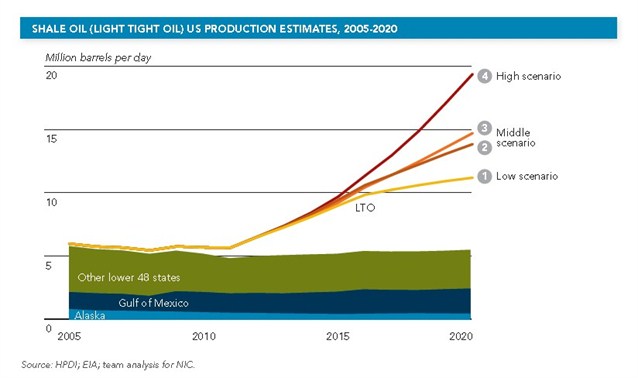The Future is Not What It Used To Be Says US Intelligence Report
 The world of 2030 will be radically transformed from our world today, according to projections in a quadrennial report by the U.S. Intelligence Community’s top analysts.
The world of 2030 will be radically transformed from our world today, according to projections in a quadrennial report by the U.S. Intelligence Community’s top analysts.The report, Global Trends 2030: Alternative Worlds, prepared by the National Intelligence Council of the Office of the Director of National Intelligence was made public recently by the ODNI.
“Global Trends 2030” identifies six “tectonic shifts” - critical changes to key features of the global environment - underpinning the megatrends that will affect how the world works. One positive “shift” sees energy independence for the U.S. in as short a period as 10 to 20 years due to abundant quantities of shale gas.
A more sinister “shift” could be the wider access to lethal and disruptive technologies such as bioterror weapons and cyber instruments, which could offer a means for individuals and small groups to inflict large-scale violence and disruption.
The report also outlines six key “game-changers” - questions regarding the global economy, governance, conflict, regional instability, technology and the role of the U.S. - which will largely determine what kind of transformed world will be inhabited in 2030.
The report projects that by 2030 the U.S. most likely will remain “first among equals” among the other great powers, due to the legacy of its leadership role in the world and the dominant role it has played in international politics across the board in both hard and soft power.
The replacement of the U.S. by another global power and construction of a new international order is an unlikely outcome in this time period, notes the report.
Nevertheless, with the rapid rise of other countries, the “unipolar moment” is over and no country - whether the U.S., China, or any other country - will be a hegemonic power.
Asia will rise to the top
In terms of the indices of overall power - GDP, population size, military spending and technological investment - Asia will surpass North America and Europe combined, states the report. In addition to rising Asian influence in geo-political terms, the report highlights growing Asian influence on the functioning of global markets, particularly for commodities.
“State-backed Asian resource investment strategies are changing the business environment for competitors in extractive industries and other infrastructure investments in developing countries,” notes the report. “Foreign direct investments by state-owned enterprises-largely based in emerging markets - have focused increasingly on mining, quarrying, and petroleum.”

Overall, commodities are now responsible for about two-thirds of foreign direct investment by state-owned enterprises. Asian countries already prioritize long-term bilateral resource supply deals for oil, gas, and coal, sealed with political and economic assistance packages.
More people, more consumers, more democracy
Population growth and the rise of consumer demands from a rapidly expanding middle class are two of the key factors behind the democraphic changes anticipated in the next two decades.
Demographic patterns especially rapid aging and growing demands on resources such as food and water, which might lead to scarcities. These trends, which exist today, are projected to gain momentum over the coming 15-20 years.
Notes the report, middle classes most everywhere in the developing world are poised to expand substantially in terms of both absolute numbers and the percentage of the population that can claim middle-class status during the next 15-20 years.

Even the more conservative models see a rise in the global total of those living in the middle class from the current 1 billion or so to over 2 billion people. The most rapid growth of the middle class will occur in Asia, with India somewhat ahead of China over the long term.
This will inevitably result in greater demand being placed on available supplies of foodstocks and water. Notes the report, “expanding middle class and swelling urban populations will increase pressures on critical resources-particularly food and water-but shortages are not inevitable.”
It predicts that new technologies - such as “vertical” farming in high-rise structures which also reduce transportation costs - could help expand needed resources. Food and water security is being aggravated by changing weather conditions outside of expected norms.
One impact of the rise in the middle class will be its impact on governance. The report predicts the empowerment of individuals, the diffusion of power among states, and from states to informal networks, will bring a growing democratization, at both the international and domestic level.
Two other “megatrends” will shape the world out to 2030: climate and energy.
More extreme weather
The report stresses the absolute certainty of climate related changes. It states “empirical evidence alone-without reference to climate models-indicates that a general warming trend is affecting weather and ecosystems, causing increasing impacts on humans.
“Recent weather has been characterized by an increase in the frequency of extreme weather events-floods, droughts, tornadoes, glacial lake outbreaks, extreme coastal high-water levels, heat waves, etc. - and this pattern almost certainly will continue during the next 20 years.”
Greenhouse gas emissions will rise also, predicts the report. It estimates that the present emissions pathway will lead to a doubling of greenhouse gases by mid-century. Based on a better understanding of climate sensitivity and emissions, this concentration will lead to approximately 2°C warming by mid-century.
“Under the present emissions pathway, 6°C is more likely than 3°C by the end of the century, and will lead to even more significant impacts. By 2030 the emissions trajectory will be cast, determining this century’s climate outcome.”
A Brighter Future for Energy
The report notes that there is a virtually certainty that the demand for energy will rise dramatically-about 50 percent-over the next 15-20 years largely in response to rapid economic growth in the developing world.
The US Energy Information Agency anticipates steadily rising global production through 2035, driven primarily by a combination of OPEC production increases and larger unconventional sources. The main or reference scenario of the International Energy Agency also posits growing global production of key fossil fuels through 2030 (about 1 percent annually for oil). (See also GLOBE-net article “ExxonMobil’s Outlook Forecasts Shift in Global Energy”)
Much of the report’s optimism about energy revolves around the increasing prospects of energy independance for the United States. Much of the forecast increased production -and recent optimism - derives from unconventional oil and gas being developed in North America.
The scale-up of two technologies, horizontal drilling and hydraulic fracturing is driving this new energy boom, notes the report. “Once the industry discovered how to combine hydraulic fracturing and horizontal drilling, the vast gas resources trapped in shale deposits became accessible.”

Natural gas also receives an honourable mention in the report. It notes the potential for more abundant and cheaper supplies of natural gas to replace coal by 2030 would have undeniable benefits for curbing carbon emissions. Nevertheless, another consequence of an increased reliance on relatively cleaner natural gas as a source of energy could be the lack of a major push on alternative fuels such as hydropower, wind, and solar energy.
In this regard, the report notes there is some uncertainty regarding the pace with which renewable energy will make significant in roads into the global energy mix.
It notes that under most scenarios, alternative fuels continue to provide a relatively small increase in the share of overall energy requirements. “The IEA’s baseline scenario shows the share of renewables rising just 4 percent during the 2007-2050 period. Hydropower accounts for the overwhelming majority of renewables in this scenario, with wind and solar energy providing 5 and 2 percent contributions in 2050 respectively.”
The Future Can Change
This is the fifth edition of Global Trends beginning with “Global Trends 2010.” As with previous reports, it does not seek to predict the future, but instead provides a framework for thinking about possible futures - assessing key trends and their implications.
The future may not be what it used to be, but it can still change if government and business policies and programs to deal with some of the underlying trends with respect to urban growth, food and water security, energy and most importantly climate adaptation change.
You can return to the main Market News page, or press the Back button on your browser.

